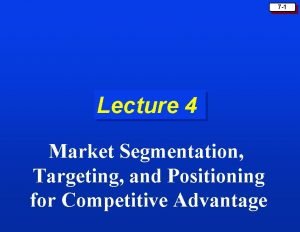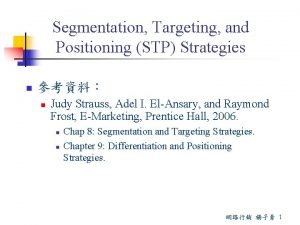Targeting Positioning Targeting Segmentation Dividing the market into











- Slides: 11

Targeting Positioning Targeting Segmentation Dividing the market into distinct subsets of consumers with common needs or characteristics Marketer then must select one or more segments to target. And specific marketing mix is decided for distinct segments. Then positioning should be done so that consumers perceive the product as satisfying their needs better than others.

Evaluating Market Segments Targeting on the basis of Overall attractiveness of the segment • Size • Growth • Profitability • Scale economies • Low Risk • Less Competition Objectives and Resources of the organization

Selecting the Market Segment Single Segment Concentration Full Market Coverage Market Specialization Product Specialization Selective Segmentation

1. Single Segment Concentration üCompany may select a single segment. Through concentrated marketing the firm gains a strong knowledge of the segment’s needs and achieves a strong market presence. üFirm enjoys operating specializing its operations. üBut economies through involves higher than normal risk. üExample: market. Volkswage concentrates on the small car Single-segment concentration P 1 P 2 P 3 M 1 M 2 M 3

2. Selective Specialization üFirm selects a number of segments, each objectively attractive and appropriate. üMulti segment coverage strategy has the advantage of diversifying the firm’s risk üThere may or may not be any synergy among the segments. M 1 P 2 P 3 M 2 M 3

3. Product Specialization üFirm specializes in making a certain product that it sells to several segments. üExample: Microscope manufacturer sells its product to: üUniversity lab üGovernment lab üCommercial lab Product specialization P 1 P 2 P 3 M 1 M 2 M 3

4. Market Specialization üFirm concentrates on serving many needs of a particular customer group. üExample: Firm that sells an assortment of products only to university laboratory. Market specialization M 1 M 2 M 3 P 1 P 2 P 3

5. Full Market Coverage attempts to serve all customer groups with all the products they might need. Full market coverage üFirm üOnly very large firms can undertake a full market coverage strategy. üExample: IBM (Computer Market) M 1 M 2 M 3 P 1 P 2 P 3

Full Market Coverage Differentiated Marketing Firm operates in several market segments and designs different programs for each segment. E. g Marriott Undifferentiated Marketing Ignores market segment differences and goes after the whole market with one market offer. E. g. Coco-Cola

Assessment

 Segmentation, targeting, positioning
Segmentation, targeting, positioning Sony market segmentation, targeting and positioning
Sony market segmentation, targeting and positioning Sony market segmentation, targeting and positioning
Sony market segmentation, targeting and positioning Nokia target market
Nokia target market Market segmentation, targeting and positioning
Market segmentation, targeting and positioning Positioning methods
Positioning methods Differentiated undifferentiated and concentrated marketing
Differentiated undifferentiated and concentrated marketing Market segmentation and targeting ppt
Market segmentation and targeting ppt Nivea target market
Nivea target market Market segmentation variable
Market segmentation variable Positioning involves meeting consumers lower performance
Positioning involves meeting consumers lower performance For upscale american families volvo
For upscale american families volvo





















